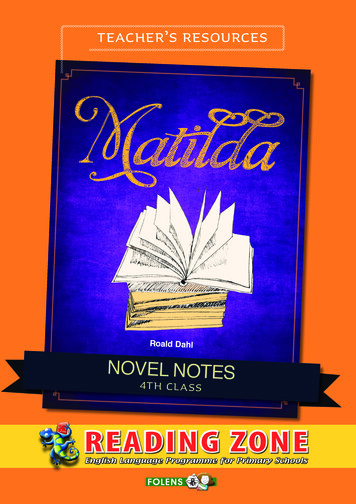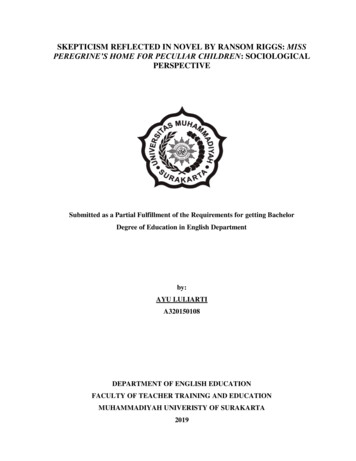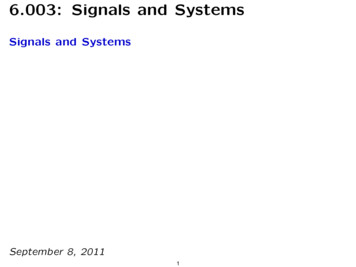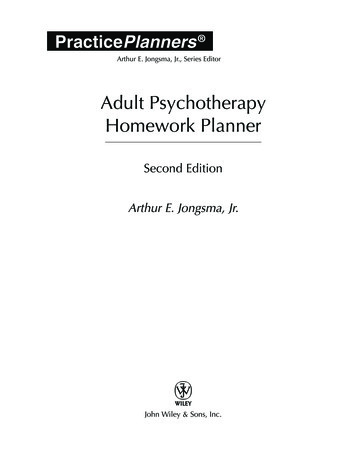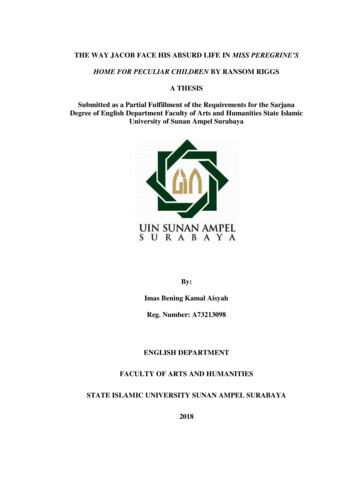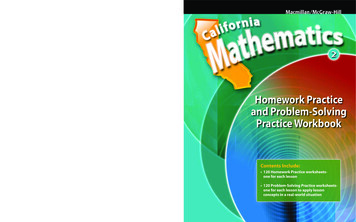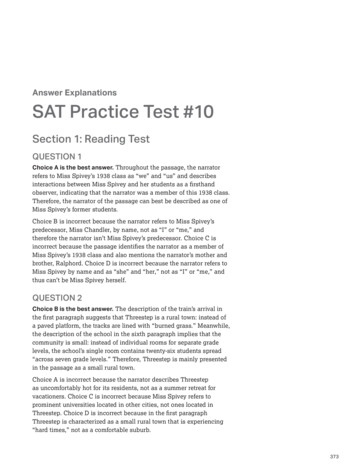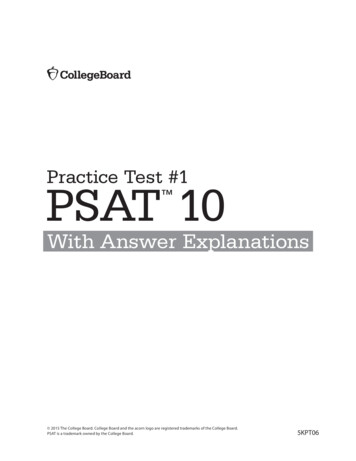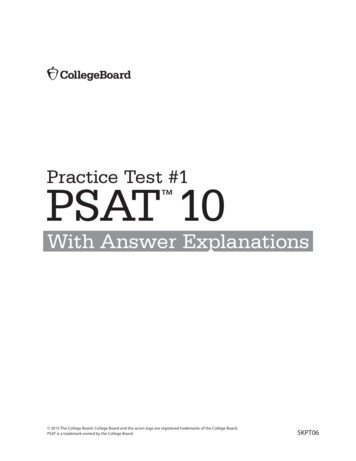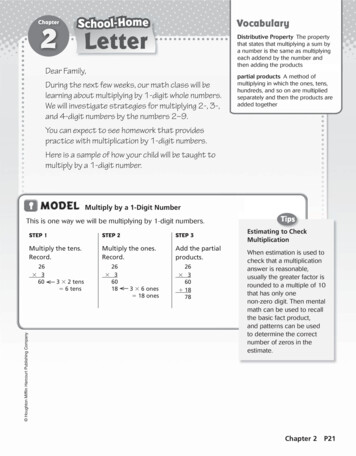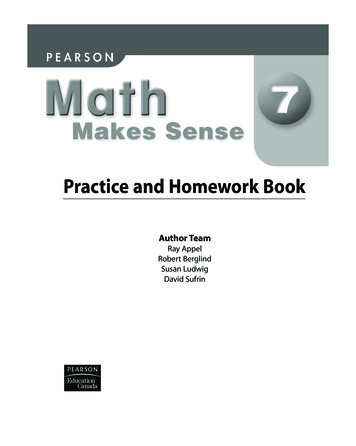
Transcription
Frontmatter Gr7P&H WNCP SE.qxd7/25/072:31 PMPage iPractice and Homework BookAuthor TeamRay AppelRobert BerglindSusan LudwigDavid Sufrin
Frontmatter Gr7P&H WNCP SE.qxd7/25/072:31 PMPage iiPublisherClaire BurnettElementary Math Team LeaderDiane WymanPublishing TeamLesley HaynesEnid HaleyIoana GageaLynne GulliverStephanie CoxJudy WilsonProduct ManagerKathleen CrosbieDesignWord & Image Design Studio Inc.TypesettingComputer Composition of Canada Inc.Copyright 2008 Pearson Education Canada, a division of Pearson Canada Inc.All Rights Reserved. This publication is protected bycopyright, and permission should be obtained fromthe publisher prior to any prohibited reproduction,storage in a retrieval system, or transmission in anyform or by any means, electronic, mechanical,photocopying, recording, or likewise. Forinformation regarding permission, write to thePermissions Department.ISBN-13: 978-0-321-43176-9ISBN-10:0-321-43176-6Printed and bound in Canada.3 4 5 -- WC -- 11 10 09 08 07
Frontmatter Gr7P&H WNCP SE.qxd7/25/072:31 PMPage iiiContentsUNIT1UNIT2Patterns and RelationsJust for Fun. . . . . . . . . . . . . . . . . . . . . . . . . . . . . . . . . . . . . . . . . . . . . . . . . . . . . . 1Activating Prior KnowledgeOrder of Operations . . . . . . . . . . . . . . . . . . . . . . . . . . . . . . . . . . . . . . . . . 2Graphing on a Coordinate Grid . . . . . . . . . . . . . . . . . . . . . . . . . . . . . . . 31.1Patterns in Division . . . . . . . . . . . . . . . . . . . . . . . . . . . . . . . . . . . . . . . . . 41.2More Patterns in Division. . . . . . . . . . . . . . . . . . . . . . . . . . . . . . . . . . . . 61.3Algebraic Expressions . . . . . . . . . . . . . . . . . . . . . . . . . . . . . . . . . . . . . . 91.4Relationships in Patterns. . . . . . . . . . . . . . . . . . . . . . . . . . . . . . . . . . . 121.5Patterns and Relationships in Tables . . . . . . . . . . . . . . . . . . . . . . . . . 141.6Graphing Relations . . . . . . . . . . . . . . . . . . . . . . . . . . . . . . . . . . . . . . . . 171.7Reading and Writing Equations. . . . . . . . . . . . . . . . . . . . . . . . . . . . . . 201.8Solving Equations Using Algebra Tiles . . . . . . . . . . . . . . . . . . . . . . . 22In Your Words . . . . . . . . . . . . . . . . . . . . . . . . . . . . . . . . . . . . . . . . . . . . . . . . . . 25Unit Review . . . . . . . . . . . . . . . . . . . . . . . . . . . . . . . . . . . . . . . . . . . . . . . . . . . . 26IntegersJust for Fun . . . . . . . . . . . . . . . . . . . . . . . . . . . . . . . . . . . . . . . . . . . . . . . . . . . . 29Activating Prior KnowledgeWhat Is an Integer?. . . . . . . . . . . . . . . . . . . . . . . . . . . . . . . . . . . . . . . . 30Comparing and Ordering Integers. . . . . . . . . . . . . . . . . . . . . . . . . . . . 312.1Representing Integers . . . . . . . . . . . . . . . . . . . . . . . . . . . . . . . . . . . . . 322.2Adding Integers with Tiles. . . . . . . . . . . . . . . . . . . . . . . . . . . . . . . . . . 342.3Adding Integers on a Number Line . . . . . . . . . . . . . . . . . . . . . . . . . . . 362.4Subtracting Integers with Tiles. . . . . . . . . . . . . . . . . . . . . . . . . . . . . . 392.5Subtracting Integers on a Number Line . . . . . . . . . . . . . . . . . . . . . . . 41In Your Words . . . . . . . . . . . . . . . . . . . . . . . . . . . . . . . . . . . . . . . . . . . . . . . . . . 44Unit Review . . . . . . . . . . . . . . . . . . . . . . . . . . . . . . . . . . . . . . . . . . . . . . . . . . . . 45iii
Frontmatter Gr7P&H WNCP SE.qxdUNIT3UNIT4iv7/25/072:31 PMPage ivFractions, Decimals, and PercentsJust for Fun . . . . . . . . . . . . . . . . . . . . . . . . . . . . . . . . . . . . . . . . . . . . . . . . . . . . 47Activating Prior KnowledgeMental Math . . . . . . . . . . . . . . . . . . . . . . . . . . . . . . . . . . . . . . . . . . . . . 48Percent . . . . . . . . . . . . . . . . . . . . . . . . . . . . . . . . . . . . . . . . . . . . . . . . . . 493.1Fractions to Decimals. . . . . . . . . . . . . . . . . . . . . . . . . . . . . . . . . . . . . . 503.2Comparing and Ordering Fractions and Decimals . . . . . . . . . . . . . . 523.3Adding and Subtracting Decimals . . . . . . . . . . . . . . . . . . . . . . . . . . . 553.4Multiplying Decimals . . . . . . . . . . . . . . . . . . . . . . . . . . . . . . . . . . . . . . 573.5Dividing Decimals. . . . . . . . . . . . . . . . . . . . . . . . . . . . . . . . . . . . . . . . . 603.6Order of Operations with Decimals . . . . . . . . . . . . . . . . . . . . . . . . . . 643.7Relating Fractions, Decimals, and Percents . . . . . . . . . . . . . . . . . . . 663.8Solving Percent Problems . . . . . . . . . . . . . . . . . . . . . . . . . . . . . . . . . . 70In Your Words . . . . . . . . . . . . . . . . . . . . . . . . . . . . . . . . . . . . . . . . . . . . . . . . . . 73Unit Review . . . . . . . . . . . . . . . . . . . . . . . . . . . . . . . . . . . . . . . . . . . . . . . . . . . . 74Circles and AreaJust for Fun . . . . . . . . . . . . . . . . . . . . . . . . . . . . . . . . . . . . . . . . . . . . . . . . . . . . 77Activating Prior KnowledgePerimeter and Area of a Rectangle . . . . . . . . . . . . . . . . . . . . . . . . . . 78Using a Protractor to Measure Angles . . . . . . . . . . . . . . . . . . . . . . . 794.1Investigating Circles. . . . . . . . . . . . . . . . . . . . . . . . . . . . . . . . . . . . . . . 804.2Circumference of a Circle . . . . . . . . . . . . . . . . . . . . . . . . . . . . . . . . . . 824.3Area of a Parallelogram. . . . . . . . . . . . . . . . . . . . . . . . . . . . . . . . . . . . 844.4Area of a Triangle . . . . . . . . . . . . . . . . . . . . . . . . . . . . . . . . . . . . . . . . . 874.5Area of a Circle . . . . . . . . . . . . . . . . . . . . . . . . . . . . . . . . . . . . . . . . . . . 904.6Interpreting Circle Graphs . . . . . . . . . . . . . . . . . . . . . . . . . . . . . . . . . . 934.7Drawing Circle Graphs. . . . . . . . . . . . . . . . . . . . . . . . . . . . . . . . . . . . . 96In Your Words . . . . . . . . . . . . . . . . . . . . . . . . . . . . . . . . . . . . . . . . . . . . . . . . . 100Unit Review . . . . . . . . . . . . . . . . . . . . . . . . . . . . . . . . . . . . . . . . . . . . . . . . . . 101
Frontmatter Gr7P&H WNCP SE.qxdUNIT5UNIT6UNIT77/25/072:31 PMPage vOperations with FractionsJust for Fun . . . . . . . . . . . . . . . . . . . . . . . . . . . . . . . . . . . . . . . . . . . . . . . . . . . 103Activating Prior KnowledgeEquivalent Fractions . . . . . . . . . . . . . . . . . . . . . . . . . . . . . . . . . . . . . . 104Relating Mixed Numbers and Improper Fractions . . . . . . . . . . . . . 1055.1Using Models to Add Fractions . . . . . . . . . . . . . . . . . . . . . . . . . . . . . 1065.2Using Other Models to Add Fractions . . . . . . . . . . . . . . . . . . . . . . . 1095.3Using Symbols to Add Fractions . . . . . . . . . . . . . . . . . . . . . . . . . . . . 1125.4Using Models to Subtract Fractions . . . . . . . . . . . . . . . . . . . . . . . . . 1155.5Using Symbols to Subtract Fractions . . . . . . . . . . . . . . . . . . . . . . . . 1185.6Adding with Mixed Numbers . . . . . . . . . . . . . . . . . . . . . . . . . . . . . . 1215.7Subtracting with Mixed Numbers. . . . . . . . . . . . . . . . . . . . . . . . . . . 123In Your Words . . . . . . . . . . . . . . . . . . . . . . . . . . . . . . . . . . . . . . . . . . . . . . . . . 125Unit Review . . . . . . . . . . . . . . . . . . . . . . . . . . . . . . . . . . . . . . . . . . . . . . . . . . . 126EquationsJust for Fun . . . . . . . . . . . . . . . . . . . . . . . . . . . . . . . . . . . . . . . . . . . . . . . . . . . 129Activating Prior KnowledgeWriting Expressions and Equations . . . . . . . . . . . . . . . . . . . . . . . . . 130Evaluating Expressions . . . . . . . . . . . . . . . . . . . . . . . . . . . . . . . . . . . 1316.1Solving Equations. . . . . . . . . . . . . . . . . . . . . . . . . . . . . . . . . . . . . . . . 1326.2Using a Model to Solve Equations . . . . . . . . . . . . . . . . . . . . . . . . . . 1356.3Solving Equations Involving Integers . . . . . . . . . . . . . . . . . . . . . . . 1386.4Solving Equations Using Algebra. . . . . . . . . . . . . . . . . . . . . . . . . . . 1416.5Using Different Methods to Solve Equations . . . . . . . . . . . . . . . . . 145In Your Words . . . . . . . . . . . . . . . . . . . . . . . . . . . . . . . . . . . . . . . . . . . . . . . . . 148Unit Review . . . . . . . . . . . . . . . . . . . . . . . . . . . . . . . . . . . . . . . . . . . . . . . . . . 149Data AnalysisJust for Fun . . . . . . . . . . . . . . . . . . . . . . . . . . . . . . . . . . . . . . . . . . . . . . . . . . . 151Activating Prior KnowledgeExperimental Probability. . . . . . . . . . . . . . . . . . . . . . . . . . . . . . . . . . 152Theoretical Probability . . . . . . . . . . . . . . . . . . . . . . . . . . . . . . . . . . . 1537.1Mean and Mode . . . . . . . . . . . . . . . . . . . . . . . . . . . . . . . . . . . . . . . . . 1547.2Median and Range . . . . . . . . . . . . . . . . . . . . . . . . . . . . . . . . . . . . . . . 1567.3The Effects of Outliers on Average. . . . . . . . . . . . . . . . . . . . . . . . . . 1587.4Applications of Averages . . . . . . . . . . . . . . . . . . . . . . . . . . . . . . . . . 1617.5Different Ways to Express Probability. . . . . . . . . . . . . . . . . . . . . . . 1647.6Tree Diagrams. . . . . . . . . . . . . . . . . . . . . . . . . . . . . . . . . . . . . . . . . . . 167In Your Words . . . . . . . . . . . . . . . . . . . . . . . . . . . . . . . . . . . . . . . . . . . . . . . . . 171Unit Review . . . . . . . . . . . . . . . . . . . . . . . . . . . . . . . . . . . . . . . . . . . . . . . . . . 172v
Frontmatter Gr7P&H WNCP SE.qxdUNIT8vi7/25/072:31 PMPage viGeometryJust for Fun . . . . . . . . . . . . . . . . . . . . . . . . . . . . . . . . . . . . . . . . . . . . . . . . . . . 175Activating Prior KnowledgeClassifying Triangles . . . . . . . . . . . . . . . . . . . . . . . . . . . . . . . . . . . . . 176Properties of a Rhombus . . . . . . . . . . . . . . . . . . . . . . . . . . . . . . . . . . 1778.1Parallel Lines . . . . . . . . . . . . . . . . . . . . . . . . . . . . . . . . . . . . . . . . . . . 1788.2Perpendicular Lines . . . . . . . . . . . . . . . . . . . . . . . . . . . . . . . . . . . . . . 1828.3Constructing Perpendicular Bisectors . . . . . . . . . . . . . . . . . . . . . . 1868.4Constructing Angle Bisectors. . . . . . . . . . . . . . . . . . . . . . . . . . . . . . 1908.5Graphing on a Coordinate Grid . . . . . . . . . . . . . . . . . . . . . . . . . . . . . 1938.6Graphing Translations and Reflections . . . . . . . . . . . . . . . . . . . . . . 1968.7Graphing Rotations. . . . . . . . . . . . . . . . . . . . . . . . . . . . . . . . . . . . . . . 199In Your Words . . . . . . . . . . . . . . . . . . . . . . . . . . . . . . . . . . . . . . . . . . . . . . . . . 202Unit Review . . . . . . . . . . . . . . . . . . . . . . . . . . . . . . . . . . . . . . . . . . . . . . . . . . 203
Frontmatter Gr7P&H WNCP SE.qxd7/25/072:32 PMPage viiutAboAddison WesleyMathMakes Sense 7Practice and Homework BookWelcome to Pearson Math Makes Sense 7. These pages describe how thisPractice and Homework Book can support your progress through the year.Each unit offers the following features.Activating Prior Knowledgeprovides a brief introduction andExamples to refresh your skills, andCheck questions to let you reinforcethese prerequisite skills.Just for Fun presents puzzles,games, or activities to help youwarm up for the content to come.You may work with key words,numeracy skills, or creative andcritical thinking skills.Key to Success highlights waysyou can develop your study skills,test-taking skills, and overallindependence as a grade 7 student.vii
Frontmatter Gr7P&H WNCP SE.qxd7/25/072:32 PMPage viiiFor each lesson of the Student Book, the workbookprovides 2 to 4 pages of support.Practice questionsprovide a structurefor your work,gradually leavingmore steps for youto complete on yourown.Quick Review covers the core conceptsfrom the lesson. If used for homework, thisQuick Review lets you take just the Practiceand Homework Book home,In Your Words helps to close each unit.This page identifies essential mathematicalvocabulary from the unit, gives one definitionas an example, and allows you to recordyour understanding of other termsin your own words.Unit Review pagesprovide the same level ofsupport as lesson Practice.Each Unit Review question isreferenced to the relevantlesson where relatedconcepts are developed.Tips and Hints point you in theright direction for success.viii
Unit 01 Gr7 P&H WNCP SE.qxd7/18/0712:44 PMPage 1UNIT1Patterns and RelationsJust for FunWord FindPattern SearchFind the following wordsin the puzzle below.You can move in any direction.termdivisibility ruleunittileChoose a grid of any 4 squares in the calendar.What patterns do you see in the numbers?May451238910 11 12 13 146715 16 17 18 19 20 2122 23 24 25 26 27 28divisetelilmribunitirytil29 30 31Variation: Choose a grid of any 9 squaresor pick a different month and try again.A Game forExpress Yourself!2 or moreMake as many words as you can from the letters of the words “algebraic expression.”The person with the most words after 3 minutes wins!1
Unit 01 Gr7 P&H WNCP SE.qxd7/18/0712:44 PMPage 2Activating Prior KnowledgeOrder of OperationsPerform operations inside the brackets first.Next, divide and multiply in order from left to right.Then add and subtract in order from left to right.The letters B, D, M, A, and Scan help you remember theorder of operations.B—BracketsD, M—Divide, MultiplyA, S—Add, SubtractExample 1Simplify.a) 10 3 2b) 12 (5 1)c) 6 2 3 1Solutiona) 10 3 2 10 – 6Multiply first.Then subtract.b) 12 (5 1) 12 6Add inside the brackets first.Then divide. 4 2c) 6 2 3 1 12 3 1 Multiply first. 4 1 5Then divide.Then add. 1. Simplify.a) 12 2 4c) 12 6 5 4 12 20 d) 10 4 22b) 20 (2 3)e) (9 5) 6 10 6 5 4f) 5 2 3 4 5
Unit 01 Gr7 P&H WNCP SE.qxd7/18/0712:44 PMPage 3Graphing on a Coordinate GridAn ordered pair, such as (5, 3), tells you the position of a point on a grid.The first number is the horizontal distance from the origin.The second number is the vertical distance from the origin.The numbers of an ordered pair are also called the coordinates of a point.Example 2Graph the points A(5, 3), B(2, 0), and C(0, 4) on a grid.To plot point A, start at 5 on thehorizontal axis, then move up 3.To plot point B, start at 2 on thehorizontal axis, then move up 0.Point B is on the horizontal axis.To plot point C, start at 0 on thehorizontal axis, then move up 4.Point C is on the vertical axis.Vertical axisSolutionCABoriginHorizontal axis 2. Write the ordered pair foreach point on the grid.3. Plot and label these points:A(0, 5), B(2, 4), E(4, 3), R(5, 0)E( , )I (2, )T( , )R( , )Vertical axisVertical axisG ( , 5)Horizontal axisHorizontal axis4. The graph shows the numberBracelets Madein 3 h?b) How long will it take to makeNumberof bracelets Jan can make over time.a) How many bracelets can Jan make10 bracelets?Time (h)3
Unit 01 Gr7 P&H WNCP SE.qxd1.17/18/0712:44 PMPage 4Patterns in Division Multiples of 2 are even numbers.They have these ones digits: 0, 2, 4, 6, 8For example, these are even numbers and multiples of 2: 32, 74, 88, 96, 100All even numbers are divisible by 2. A number is a multiple of 4 if the tens and ones digits of the numberform a number that is a multiple of 4.For example, 124 is a multiple of 4 because 24 is a multiple of 4.And, 3036 is a multiple of 4 because 36 is a multiple of 4. Multiples of 5 have these ones digits: 0, 5For example, these numbers are multiples of 5: 5, 20, 45, 350Multiples of 5 are divisible by 5. A number is a multiple of 8 if the hundreds, tens, and ones digitsof the number form a number that is a multiple of 8.For example, 1888 is a multiple of 8 because 888 is a multiple of 8.And, 1040 is a multiple of 8 because 040, or 40 is a multiple of 8. Multiples of 10 have a ones digit that is 0.For example, these numbers are multiples of 10: 20, 40, 130, 770Multiples of 10 are divisible by 10. You can use a Venn diagram to show numbers that are divisibleby two or more numbers.This Venn diagram shows divisibility by 2 and by 5.Divisible by 2Divisible by 52125640703225656109855105315941Multiples of 2 are in the left loop.Multiples of both 2 and 5 are in the middle loop.Multiples of 5 are in the right loop.Numbers that are not multiples of 2 or of 5 are outside the loops.4hoolQuick ReviewmeAt ScAt Ho
Unit 01 Gr7 P&H WNCP SE.qxd7/18/0712:44 PMPage 5H1. Circle the numbers that are divisible by 2.2398214411The ones digits innumbers divisible by 2are even.773477510252. Circle the numbers that are divisible by 5.55107591053. Circle the numbers that are divisible by 2 and by 5.103025551000HI N TThe ones digits innumbers divisible by 5are 0 or 5.524. Write each number in the correct place inI N TDivisible by 4Divisible by 5the Venn diagram.16, 20, 33, 64, 80, 95, 97, 105, 214, 216, 324, 4055. Write four 3-digit numbers that are divisible by 10.6. Write three 4-digit numbers that are divisible by 8.7. a) Write each number in the correct place inDivisible by 8Divisible by 10the Venn diagram.115, 116, 120, 168, 450, 753, 800, 928, 1008, 1110b) Write 4 more numbers in the Venn diagram – onein each loop and one outside the loops. How doyou know you placed each number correctly?5
Unit 01 Gr7 P&H WNCP SE.qxd1.27/18/0712:44 PMPage 6More Patterns in Division A number is divisible by 3 if the sum of its digits is divisible by 3. For example,1035 is divisible by 3 because 1 0 3 5 9, and 9 is divisible by 3.1036 is not divisible by 3 because 1 0 3 6 10, and 10 is not divisible by 3.hoo A number is divisible by 6 if the number is divisible by 2 and by 3. For example,1038 is divisible by 2 because the number is even.1038 is divisible by 3 because 1 0 3 8 12, which is divisible by 3.So, 1038 is divisible by 6. A number is divisible by 9 if the sum of its digits is divisible by 9. For example,5418 is divisible by 9 because 5 4 1 8 18, and 18 is divisible by 9.5428 is not divisible by 9 because 5 4 2 8 19, and 19 is not divisible by 9. No number is divisible by 0. You can use a Carroll diagram to show numbers that are divisible by two numbers.This Carroll diagram shows divisibility by 6 and by 9.Divisible by 9Not divisible by 9Divisible by 618, 36, 126, 1626, 12, 204, 402Not divisible by 627, 45, 963, 71110, 29, 325, 802 You can use divisibility rules to help list the factors of a number.To list the factors of 156:Try each rule in turn.Divide by 2: 156 2 78Divide by 3: 156 3 52Divide by 4: 156 4 39156 is not divisible by 5.Divide by 6: 156 6 26156 is not divisible by 7, by 8, by 9, or by 10.Use a calculator to check for divisibility by 11 and 12.156 is not divisible by 11.Divide by 12: 156 12 13Since the factors 12 and 13 are close in value, you have found all the factors.In order, the factors of 156 are: 1, 2, 3, 4, 6, 12, 13, 26, 39, 52, 78, 1566lQuick ReviewmeAt ScAt Ho
Unit 01 Gr7 P&H WNCP SE.qxd7/18/0712:44 PMPage 71. Match the number with the correct divisibility statement.Draw more than one line if it is needed.54Divisible by 10.56Divisible by 3.50Divisible by 9.92Divisible by 8.75Divisible by 5.93Divisible by 2.30Divisible by 6.2. Cross out the numbers that are not divisible by 2.1279981342272469How do you know the numbers are not divisible by 2?3. Circle the numbers that are divisible by 9.913313331539912 321How do you know you are correct?4. Write four numbers that are divisible by 6:How did you choose those numbers?5. Solve each riddle.a) I am divisible by 2 and by 3.I am between 21 and 29.Which number am I?2122232425b) I am divisible by 5 and by 10.I am between 56 and 64.Which number am I?26272829c) I am divisible by 2 and by 9.I am between 424 and 449.Which number am I?7
Unit 01 Gr7 P&H WNCP SE.qxd7/18/0712:44 PMPage 86. Which numbers below are divisible by 3? By 6? By 9?How do you know?a) 124b) 215c) 330d) 450e) 1507. Use your answers to question 6 to help you list the factors of each number.a) 124:b) 215:c) 150:8. a) Sort these numbers in the Carroll diagram below.16, 18, 27, 37, 120, 180, 281, 288, 352, 411, 432, 540Divisible by 9Not divisible by 9Divisible by 4Not divisible by 4b) Write one more number in each part of the Carroll diagram.Explain how you knew where to place each number.9. a) Sort these numbers in the Venn diagram.Multiples of 4Multiples of 612, 28, 36, 54, 72, 79, 135, 256, 270, 318, 371, 432b) Which loop is empty?Explain why there is no number that belongs in that loop.Multiples of 98
Unit 01 Gr7 P&H WNCP SE.qxd7/18/071.312:44 PMPage 9Algebraic ExpressionsQuick ReviewmeAt ScAt Ho Algebraic expressions contain variables such as x and n.x and n can represent any numbers you choose.lhooHere are some examples of algebraic expressions and what they mean.x 5:Five more than a numbern 3:Three less than a number3 n:Three subtract a number5x:Five times a number5n 3:Five times a number, then add 3; orthree more than five times a number100nn100:One hundred divided by a number:A number divided by one hundred In the algebraic expression 7t 27 is the numerical coefficient of the variable.2 is the constant term.t is the variable. An algebraic expression can help you solvesimilar problems more efficiently. Once youknow the algebraic expression, you can useit again, even if the numbers change.Suppose you earn 8 per hour.HI N TIf you see how to solve aproblem using numbers, thenyou can write an algebraicexpression for the problem.Replace the number thatchanges with a variable.For 3 hours, you earn: 3 8 24For t hours, you earn: t 8 8t dollars To evaluate an expression means to substitute a number for the variable,then calculate the answer.H I N TTo evaluate 2a – 5 for a 7:Recall that 2a means 2 x a.Replace a with 7 in the expression 2a – 5.Use the order of operations.2a – 5 2(7) – 5Multiply before subtracting. 14 – 5 99
Unit 01 Gr7 P&H WNCP SE.qxd7/18/0712:44 PMPage 101. Match each algebraic expression with its meaning.6 xFive less than a number4nOne more than double a number1 2tFive subtract a number5–pFour times a numbers–5Three times a number subtract four3g – 4Six more than a number2. Identify the numerical coefficient, the variable, and the constant term in each expression.a) 4 5sNumerical coefficient:Variable:Constant term:Variable:Constant term:Variable:Constant term:b) x 7Numerical coefficient:c) 9mNumerical coefficient:3. An algebraic expression has constant term 12, variable t, and numerical coefficient 8.What might the expression be?4. Write an algebraic expression for each phrase.Use the variable n.a) Ten times a number b) Double a numberc) A number divided by fourd) Six less than a numbere) Three more than ten times a numberf) Six less than ten times a number5. A clerk earns 12 an hour.Find how much the clerk earns for each time.a) 5 h workb) 8 h work5 c) p hours work 6. A car travels at an average speed of 60 km/h.Find how far it travels in each time.a) 3 hb) 5 h3 10 c) x hours
Unit 01 Gr7 P&H WNCP SE.qxd7/18/0712:44 PMPage 117. Evaluate each expression by replacing z with 10.a) z 5 10 5b) 8 z c) z – 6 d) 15 – z e) 3z f) 5z 8. Evaluate each expression by replacing n with 2.a) 2n 3c)b) 20 – 5n 2 3 – 5 2 3 n2 8d) 14 –TipUse the order of operations:B — BracketsD, M — Divide, MultiplyA, S — Add, Subtractn2 9. Sofia works part-time in a convenience store.She earns 6/h during the day, and 8/h during the evening.a) In one week, Sofia worked 10 h in the day and 9 h in the evening.Write an expression for her earnings in dollars.b) Suppose Sofia works n hours in the day and 7 h in the evening.i) Write an expression for her earnings in dollars.ii) How much does Sofia earn when n 5?c) Suppose Sofia works 9 h in the day andm hours in the evening.i) Write an expression for her earnings in dollars.ii) How much does Sofia earn when m 11?Key tO SuccessEvaluating algebraicexpressions is an importantskill. Carpenters, computerscientists, designers,electricians, and automechanics all use this skill tosolve problems on the job.11
Unit 01 Gr7 P&H WNCP SE.qxd1.47/18/0712:44 PMPage 12Relationships in PatternsQuick Review18216324432540648We can write an algebraic expression for the term when we know the term number.Each term is 8 times the term number.Let n represent any term number.Then the term is represented by 8 n, or 8n.When you compare or relate a variable to an expression that contains the variable,you have a relation.The variable is n.The expression is 8n.The relation is: 8n is related to n The table and relation above can represent the total number of beats in a music scorewhen there are 8 beats in each bar.Number of bars of musicTotal number of beats18216324432540648You can use the relation to find the number of beats in 17 bars of music.Substitute n 17 in the expression 8n.8n 8(17) 136There are 136 beats in 17 bars of music.1. Complete each chart.a) Term numberTermb) Term numberc)121251Term5Term number1Term334152339625472556945156lhoo You can describe a number pattern using the term number.Term numberTermmeAt ScAt Ho
Unit 01 Gr7 P&H WNCP SE.qxd7/18/0712:44 PMPage 132. Every day, Ray rides his bike 12 km around Stanley Park.Complete the chart to show the total distance Ray travelled.Number of daysDistance (km)11223456723. Write a relation for the pattern rule for each pattern.Use the relation to find the 12th term.Let n represent any term number.a) 6, 12, 18, 24, . . . . . .b) 10, 11, 12, 13, . . . . . .4. a) Write a relation for the perimeter of a regular pentagonnwith side length n centimetres.b) What is the perimeter of a regular pentagon with side length 9 cm?5. Ally is organizing an end-of-term party.The cost to rent the hall is 100. The cost of food is 8 per person.a) Write a relation for the total cost of the party, in dollars, for n people.b) How much will the party cost if:i) 20 people attend?ii) 50 people attend?c) How does the relation in part a change in each case?i) The cost of food doubles.ii) The cost of the food increases by 2 per person.d) For each scenario in part c, find the cost when 40 people attend.i)ii)13
Unit 01 Gr7 P&H WNCP SE.qxd1.57/18/0712:44 PMPage 14Patterns and Relationships in Tables You can make a table of values for a relation such as: 2n 5 is related to nChoose values for n. These are Input numbers.Substitute each value of n in 2n 5 to get the Output numbers.When n 1, 2n 5 2(1) 5 7When n 2, 2n 5 2(2) 5 9When n 3, 2n 5 2(3) 5 11When n 4, 2n 5 2(4) 5 13Here is the table:InputnOutput2n 51729311413 You can find a relation given its table of values. 1 1 1 1InputOutput1226310414518 4 4 4 4Let n represent any Input number.When n increases by 1, the Output number increases by 4.This means that the expression for the Output numbers contains 4n.So, compare the Output numbers to multiples of 4: 4, 8, 12, 16, 20, . . .Each Output number is 2 less than a multiple of 4.So, the output is 4n – 2.The table shows how 4n – 2 relates to n.14hoolQuick ReviewmeAt ScAt Ho
Unit 01 Gr7 P&H WNCP SE.qxd7/18/0712:44 PMPage 151. a) Evaluate the expression 3n 1.When n 1, 3n 1 3(1) 1 When n 2, 3n 1 3(2) 1 When n 3, 3n 1 3(3) When n 4, 3n 1 3( ) When n 5, 3n 1 3( ) b) Complete the table. Use your results from part a.InputnOutput3n 1123452. Complete each table.Explain how the Output number is related to the Input number.a)InputnOutputn 5b)InputbOutput8–bc)Inputa111222333444555Output6 a15
Unit 01 Gr7 P&H WNCP SE.qxd7/18/0712:44 PMPage 163. Complete each table.a)InputdOutput2d 3b)InputfOutput3f – 2c)Inputh111222333444555Output5h 14. Use algebra. Write a relation for each tput01821216432324454343256545405. Use algebra. Write a relation for each table.Then extend each table 3 more t2192521483831941041142451251452916b)
Unit 01 Gr7 P&H WNCP SE.qxd7/18/071.612:44 PMPage 17Graphing RelationsQuick ReviewOutput5n – 41126Graph of 5n – 4 against n2420 1 1Output 5 5 1 13114165lhoo You can use a graph to show a relation.This table and graph show how 5n – 4 relates to n.InputnmeAt ScAt Ho 512840 521161152 3 4 5InputThe scale on the Output axis is 1 square to 4 units.The points lie on a straight line, so the relation is linear.Both the table and the graph show that when the input increases by 1,the output increases by 5.1. Complete each table.a)InputnOutput2n 81b)InputnOutput5n 55566677717
Unit 01 Gr7 P&H WNCP SE.qxd7/18/0712:44 PMPage 182. Choose a suitable scale.Graph each relation in question 1.b)c)InputOutputOutputOutputa)InputInput3. Look at the graph at the right.b) Which input gives an output of 13?c) Extend the graph.i) What is the output when the input is 8?Outputa) What is the output when the input is 1?1284ii) What is the input when the output is 21?01 2 3 4 56 7Input4. a) Complete this table.Inputab) Graph the relation in part a.Output5a 3246810c) How does the graph illustrate the relation?18
Unit 01 Gr7 P&H WNCP SE.qxd7/18/0712:44 PMPage 195. The members of the student council wash cars to raise money for charity.The students charge 3.00 per car.a) Let c represent the number of cars washed.Write a relation to show how the money collected, in dollars, is related to the numberof cars washed.b) Complete this table to show the relation.Number of carsc) Graph the data.Money collected( )1020304050d) Describe the graph.e) Use the relation, the graph, or the table to answer these qu
Math Makes Sense 7 Practice and Homework Book Activating Prior Knowledge provides a brief introduction and Examples to refresh your skills, and Check questions to let you reinforce these prerequisite skills. Key to Successhighlights ways you can develop your study skills, test-taki

